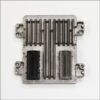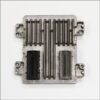Restore Your Truck’s Brain and Get Back on the Road
Is your 2008 Chevrolet Avalanche 1500 giving you headaches? Unexplained stalling, a persistent Check Engine Light, or a complete no-start condition can often point directly to a failing Engine Control Module (ECM). As the central computer of your vehicle, a faulty ECM can cause a cascade of frustrating and confusing problems. This isn’t just an inconvenience; it’s a critical failure that affects performance, fuel economy, and safety. This replacement ECM, part number 12622141, is the reliable, straightforward solution you need.
Forget the hassle and expense of a dealership visit for programming. We handle the critical software step for you. Simply provide your vehicle’s VIN during checkout, and our technicians will flash this module with the latest, most stable General Motors software specific to your Avalanche. This ensures all factory parameters for your engine and transmission are perfectly matched, restoring the performance and reliability you depend on. This is the most efficient way to solve complex electronic issues and get your truck running right again.
A Technician’s Notebook: The No-Communication Nightmare
I had a 2008 Sierra 1500 (which uses the same platform as the Avalanche) towed into the shop last month. The customer said it died at a stoplight and wouldn’t restart. The dash lights would flicker, but the engine wouldn’t crank. My scan tool couldn’t communicate with the ECM—a dead giveaway. After verifying power and ground to the module, I knew the internal processor had failed. In the past, this meant towing it to the dealer. Instead, we ordered one of these pre-programmed modules. The next day, it arrived, we performed the 15-minute swap and a quick security relearn, and the truck fired up instantly. The customer saved hundreds in programming fees and tow bills. This is the modern, smart way to handle ECM failure.
Is Your Avalanche Showing These Signs of ECM Failure?
A failing computer can manifest in many ways. If you’re experiencing any of the following, a faulty 2008 Avalanche 1500 ECM is a likely culprit:
- ✔ Complete no-start or no-crank condition.
- ✔ Check Engine Light is illuminated with communication-related Diagnostic Trouble Codes (DTCs) like U0100, U0101.
- ✔ Internal module failure codes such as P0601, P0606, or P062F are present.
- ✔ Engine stalls intermittently, especially when warm.
- ✔ Noticeable decrease in fuel economy.
- ✔ Harsh or erratic automatic transmission shifting.
- ✔ Cooling fans running constantly or not at all.
A Straightforward Guide to Installation
Replacing the ECM on your Avalanche is a job most DIY mechanics can handle. With our pre-programmed module, you eliminate the most complicated step. Follow this general guide for a successful installation.
- Safety First: Always disconnect the negative terminal from your vehicle’s battery and wait 10 minutes for capacitors to discharge.
- Locate the ECM: On the 2008 Avalanche 1500, the ECM is typically found in the engine compartment on the driver’s side, mounted under the battery tray. You will need to remove the battery to access it.
- Disconnect the Module: Carefully unplug the electrical connectors from the old ECM. These connectors have locking tabs that must be released before they can be removed. Avoid forcing them.
- Swap the Modules: Unbolt the old ECM from its mounting bracket and set it aside. Secure the new module in its place.
- Reconnect Everything: Firmly plug the wiring harnesses into the new ECM until they click into place. Reinstall the battery and connect the negative battery terminal.
- Perform Security Relearn: A key-cycle security relearn procedure is often required for the vehicle to recognize the new ECM. This typically involves turning the key to the ‘ON’ position for 10-15 minutes, then ‘OFF’, and repeating two more times before starting the engine. Instructions are readily available online for your specific model.
Verified Vehicle Compatibility
This module is a direct replacement for part numbers 12622141, 12612384, and 12617568 and fits a wide range of GM vehicles. Please confirm your vehicle is on this list. Proper programming to your VIN ensures it functions correctly for your specific application.
CAPRICE 11 (ID 12612384)
CORVETTE 08-09 (RH engine compartment)
CTS 08 (3.6L, VIN 7, ID 12612384)
ESCALADE / ESV / EXT 08 (LH front under battery)
EXPRESS / SAVANA VANS 08 (Gasoline Engines)
HUMMER H2 08 (LH front under battery)
SIERRA / SILVERADO 1500 08 (LH front under battery)
SIERRA / SILVERADO 2500/3500 08 (6.0L, LH front under battery)
SUBURBAN 1500 / 2500 08 (LH front under battery)
TAHOE / YUKON / YUKON XL 08 (LH front under battery)
…and many other GM cars and SUVs from 2008-2009.
Frequently Asked Questions
Does this module need to be programmed by a dealer?
No. We program this module to your vehicle’s specific VIN before shipping it to you. It arrives ready for installation and a simple security relearn procedure, saving you time and money.
What is a ‘security relearn’ and is it difficult?
A security relearn, or key-cycle relearn, is a simple procedure that synchronizes your vehicle’s anti-theft system with the new ECM. It usually involves turning the ignition on and off in a specific sequence. It requires no special tools and instructions can easily be found online.
Where do I find my VIN?
Your 17-digit Vehicle Identification Number (VIN) can be found on your vehicle’s registration, insurance card, or on a metal plate on the driver’s side of the dashboard, visible through the windshield.
Is this a reliable fix for my 2008 Avalanche 1500 ECM problems?
Absolutely. This module is tested for full functionality and programmed with the latest GM software updates, which can correct issues present in the original factory programming. It’s a dependable solution to restore your truck’s operation.
Will this fix my transmission shifting problems?
In many cases, yes. The ECM works directly with the Transmission Control Module (TCM) to manage shift points. If the ECM is faulty, it can send incorrect data, leading to poor shifting. Replacing a bad ECM often resolves these related transmission symptoms.



